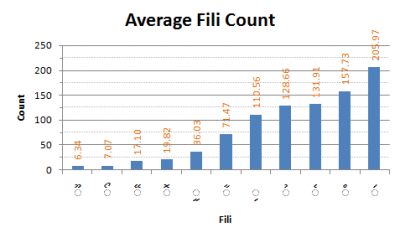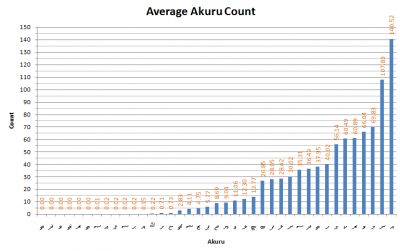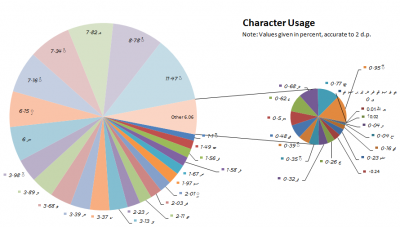Sunday, February 8. 2009
Geo-mapped visualization of political party member distribution in Male'
Here is a quick mashup I cooked up today, displaying the geographic distribution of political party membership on the map of Male' on Google Maps. To view the distribution for a party, open the link for the visualization, select the name of the political party from the drop-down menu at the top right. The addresses of members of that party will then be flagged with a little red marker. You will be able to zoom in-out, pan and do all those other things typically seen in Google Maps. Click a red marker to see more details about that address, like the number of people belonging to the selected party that are registered under that address.
The party membership information used for this is a snapshot of the data (taken 7 February 2009) published on the Members of Political Parties web portal by the Elections Commission. There were a total of 4,447 people belonging to 2,711 addresses in Male' listed in the Elections Commission data. Each party had membership numbers (given in brackets) in Male' as follows: Adhaalathu Party (175), Dhivehi Qaumee Party (261), Dhivehi Rahjeyn Fageerukan Nahthaalumah Masahkaikuraa Party (650), Dhivehi Rayyithunge Party (243), Gaumee Ih'thihaadh (592), Islamic Democratic Party (89), Jumhooree Party (246), Maldivian Democratic Party (507), Maldivian National Congress (386), Maldivian Social Democratic Party (25), Peoples Party (476), Peoples' Alliance (422) and Social Liberal Party (375). The maximum number of persons listed on a single address for a party was 12 and the average was 1 person per address (per party).
The geo-location information for the addresses was derived from the excellent services at Male-map.com and EAtolls.com. A total of 1,928 addresses were successfully mapped using these services, leaving a difference of 783 addresses which were then discarded. It is worth noting that of these addresses left out, 478 were just Dhaftharu numbers.
Please note that I neither claim nor guarantee the correctness or the completeness of any of the information used. That said, I did my best to ensure data integrity throughout the whole process of generating the visualizations.
- Click here to view the visualization
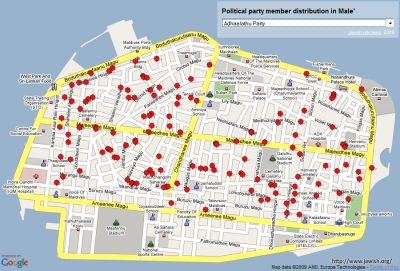
Snapshot: Adhaalathu Party
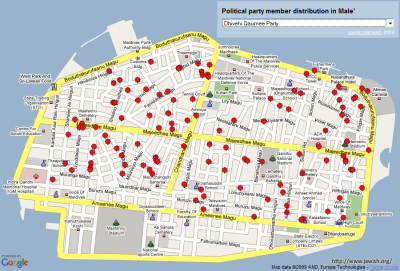
Snapshot: Dhivehi Qaumee Party
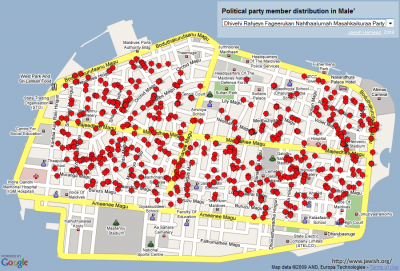
Snapshot: Dhivehi Rahjeyn Fageerukan
Nahthaalumah Masahkaikuraa Party
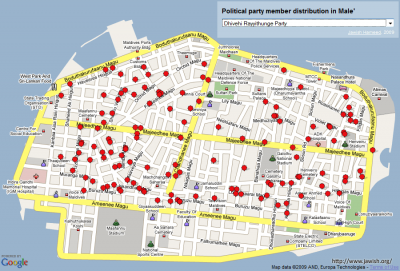
Snapshot: Dhivehi Rayyithunge Party
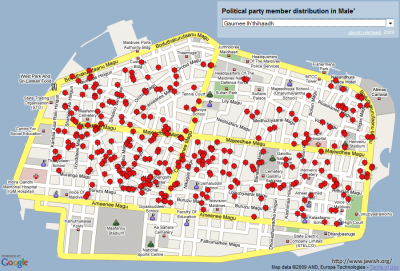
Snapshot: Gaumee Ih'thihaadh
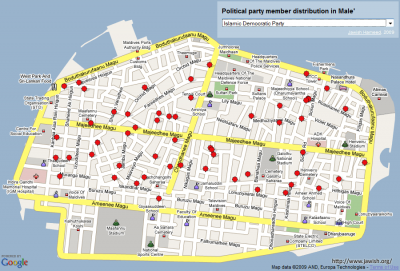
Snapshot: Islamic Democratic Party
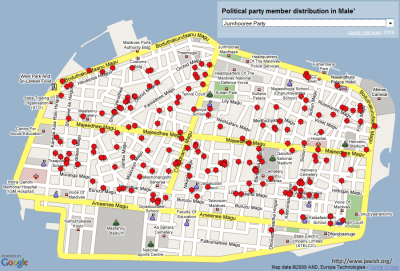
Snapshot: Jumhooree Party
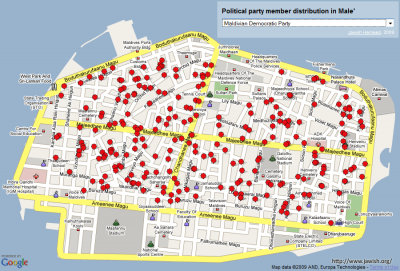
Snapshot: Maldivian Democratic Party
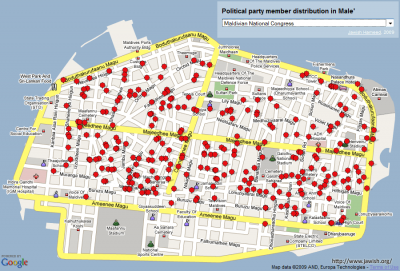
Snapshot: Maldivian National Congress
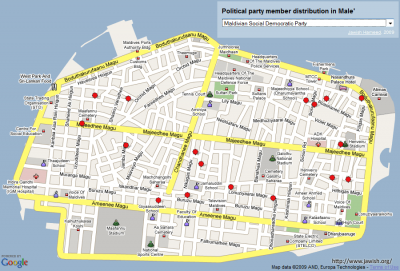
Snapshot: Maldivian Social Democratic Party
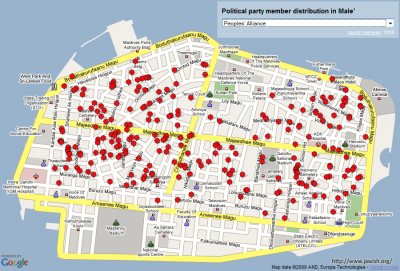
Snapshot: Peoples' Alliance
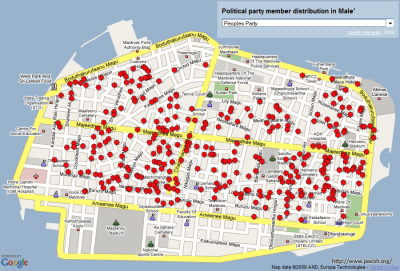
Snapshot: Peoples Party
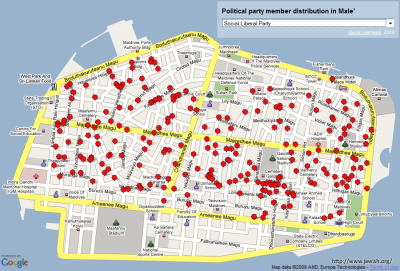
Snapshot: Social Liberal Party
The party membership information used for this is a snapshot of the data (taken 7 February 2009) published on the Members of Political Parties web portal by the Elections Commission. There were a total of 4,447 people belonging to 2,711 addresses in Male' listed in the Elections Commission data. Each party had membership numbers (given in brackets) in Male' as follows: Adhaalathu Party (175), Dhivehi Qaumee Party (261), Dhivehi Rahjeyn Fageerukan Nahthaalumah Masahkaikuraa Party (650), Dhivehi Rayyithunge Party (243), Gaumee Ih'thihaadh (592), Islamic Democratic Party (89), Jumhooree Party (246), Maldivian Democratic Party (507), Maldivian National Congress (386), Maldivian Social Democratic Party (25), Peoples Party (476), Peoples' Alliance (422) and Social Liberal Party (375). The maximum number of persons listed on a single address for a party was 12 and the average was 1 person per address (per party).
The geo-location information for the addresses was derived from the excellent services at Male-map.com and EAtolls.com. A total of 1,928 addresses were successfully mapped using these services, leaving a difference of 783 addresses which were then discarded. It is worth noting that of these addresses left out, 478 were just Dhaftharu numbers.
Please note that I neither claim nor guarantee the correctness or the completeness of any of the information used. That said, I did my best to ensure data integrity throughout the whole process of generating the visualizations.
- Click here to view the visualization

Snapshot: Adhaalathu Party

Snapshot: Dhivehi Qaumee Party

Snapshot: Dhivehi Rahjeyn Fageerukan
Nahthaalumah Masahkaikuraa Party

Snapshot: Dhivehi Rayyithunge Party

Snapshot: Gaumee Ih'thihaadh

Snapshot: Islamic Democratic Party

Snapshot: Jumhooree Party

Snapshot: Maldivian Democratic Party

Snapshot: Maldivian National Congress

Snapshot: Maldivian Social Democratic Party

Snapshot: Peoples' Alliance

Snapshot: Peoples Party

Snapshot: Social Liberal Party


